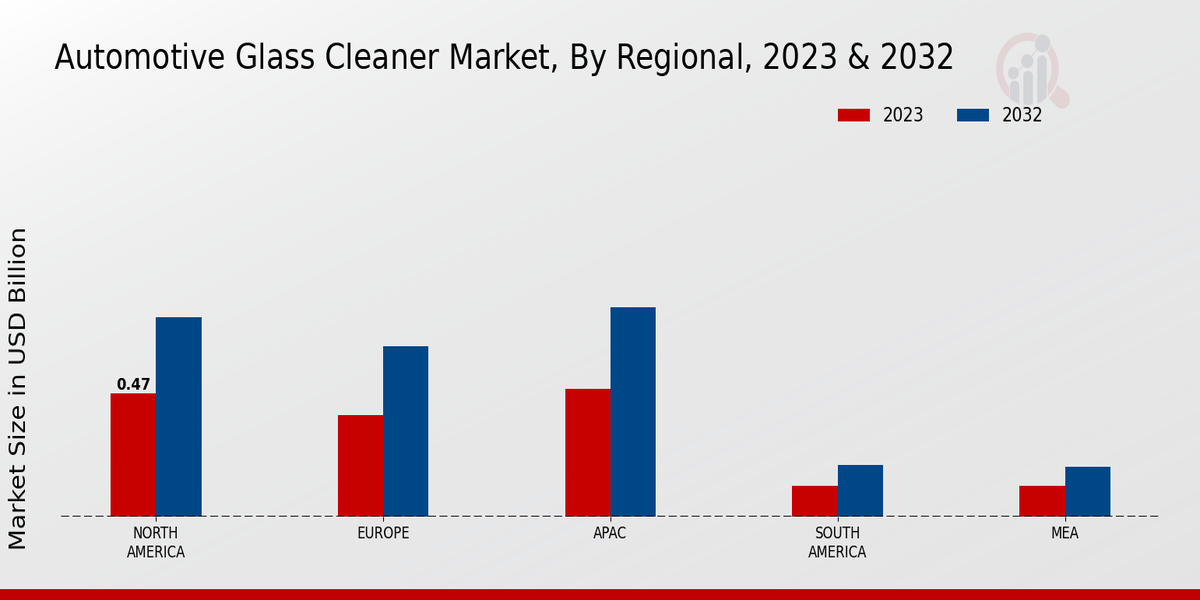Market Growth Projections
The Global Automotive Glass Cleaner Market Industry is poised for substantial growth, with projections indicating a market value of 1.76 USD Billion in 2024 and an anticipated increase to 3.05 USD Billion by 2035. This growth trajectory suggests a compound annual growth rate (CAGR) of 5.12% from 2025 to 2035. Such figures reflect the increasing demand for automotive glass cleaning solutions driven by factors such as rising vehicle ownership, heightened awareness of road safety, and advancements in cleaning technology. The market's expansion is indicative of broader trends within the automotive sector, highlighting the importance of maintenance products in ensuring vehicle longevity and safety.
Focus on Vehicle Maintenance
A heightened emphasis on vehicle maintenance and care is significantly influencing the Global Automotive Glass Cleaner Market Industry. Consumers are increasingly aware of the importance of maintaining vehicle aesthetics and safety, which includes keeping windows and windshields clean. This trend is supported by the growing number of car detailing services that promote the use of specialized cleaning products. As a result, the market is expected to grow, with projections indicating a rise to 3.05 USD Billion by 2035. This focus on maintenance not only enhances the longevity of vehicles but also contributes to the overall safety of drivers and passengers, thereby driving demand for automotive glass cleaners.
Increasing Vehicle Ownership
The rise in global vehicle ownership is a primary driver of the Global Automotive Glass Cleaner Market Industry. As more individuals acquire vehicles, the demand for maintenance products, including glass cleaners, escalates. In 2024, the market is projected to reach 1.76 USD Billion, reflecting the growing need for effective cleaning solutions. This trend is particularly evident in emerging economies where vehicle ownership rates are surging. The increase in urbanization and disposable income further fuels this demand, as consumers seek to maintain their vehicles in optimal condition. Thus, the expansion of the automotive sector directly correlates with the growth of the glass cleaner market.
Rising Awareness of Road Safety
The growing awareness of road safety is a crucial driver for the Global Automotive Glass Cleaner Market Industry. Clean and clear windshields are essential for safe driving, as they significantly enhance visibility. As safety regulations become more stringent, consumers are motivated to invest in quality glass cleaning products to ensure compliance and enhance their driving experience. This trend is reflected in the increasing sales of automotive glass cleaners, as consumers prioritize safety alongside aesthetics. The market's growth trajectory suggests that as awareness of road safety continues to rise, so too will the demand for effective automotive glass cleaning solutions.
Expansion of E-commerce Platforms
The rapid expansion of e-commerce platforms is transforming the Global Automotive Glass Cleaner Market Industry. Online retailing provides consumers with convenient access to a wide range of automotive cleaning products, including glass cleaners. This shift towards online shopping is particularly appealing to younger consumers who prefer the ease of purchasing products from home. As e-commerce continues to grow, it is expected to drive sales in the automotive glass cleaner segment. The increasing availability of diverse products through online channels is likely to enhance consumer choice and stimulate market growth, contributing to the overall expansion of the industry.
Technological Advancements in Cleaning Products
Innovations in cleaning technology are reshaping the Global Automotive Glass Cleaner Market Industry. Manufacturers are developing advanced formulations that enhance cleaning efficiency and reduce environmental impact. For instance, eco-friendly glass cleaners that utilize biodegradable ingredients are gaining traction among environmentally conscious consumers. This shift towards sustainable products is likely to attract a broader customer base, particularly as regulations around chemical usage become stricter. The anticipated compound annual growth rate (CAGR) of 5.12% from 2025 to 2035 underscores the potential for growth driven by these technological advancements, as consumers increasingly seek effective yet environmentally responsible cleaning solutions.




















